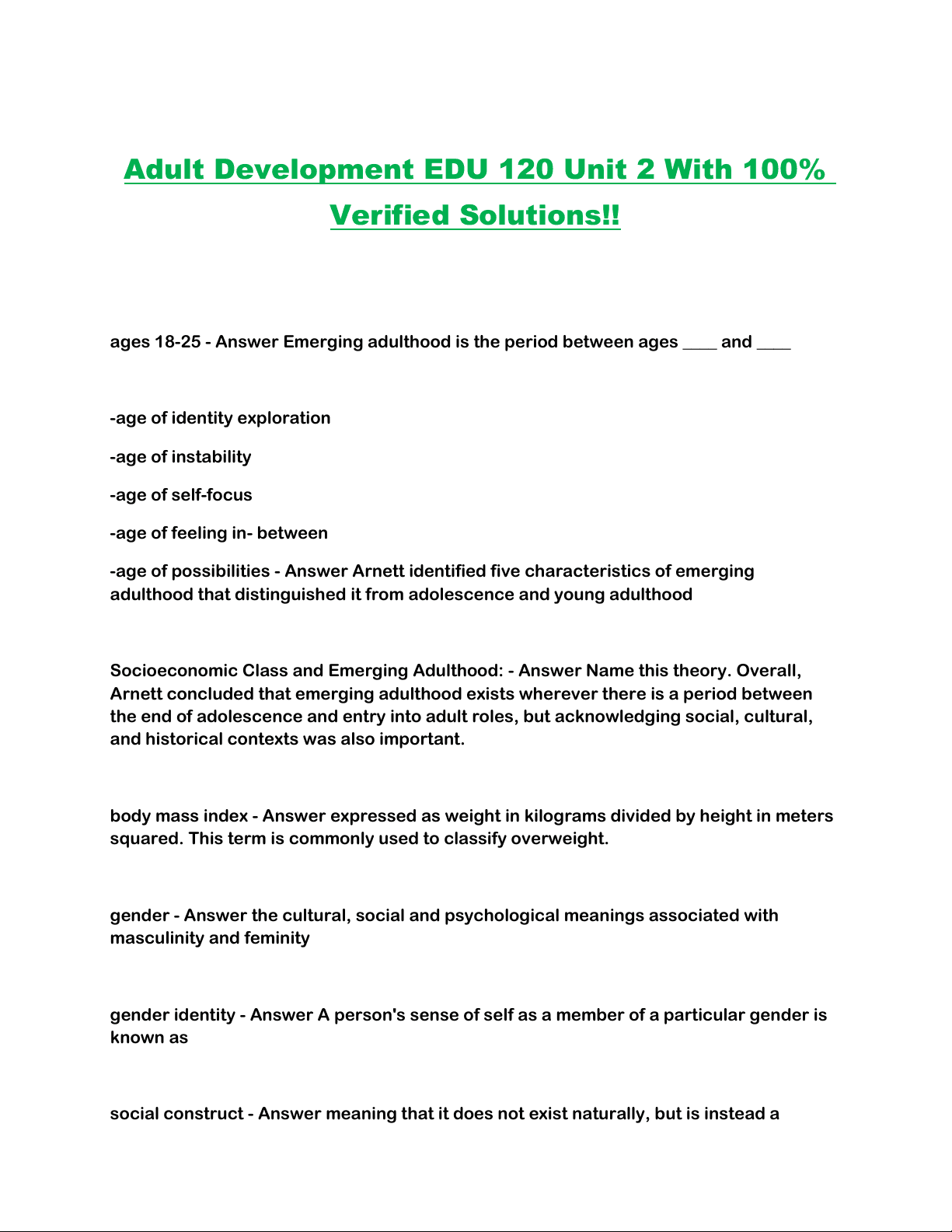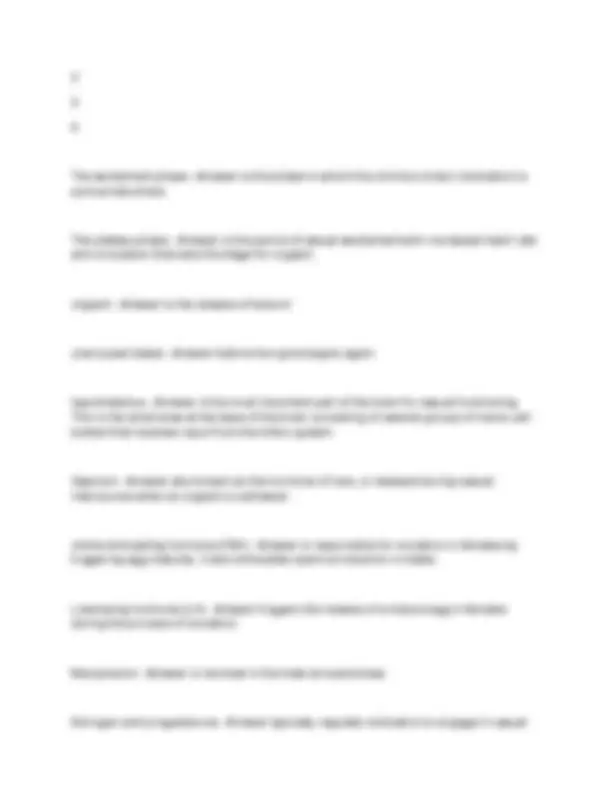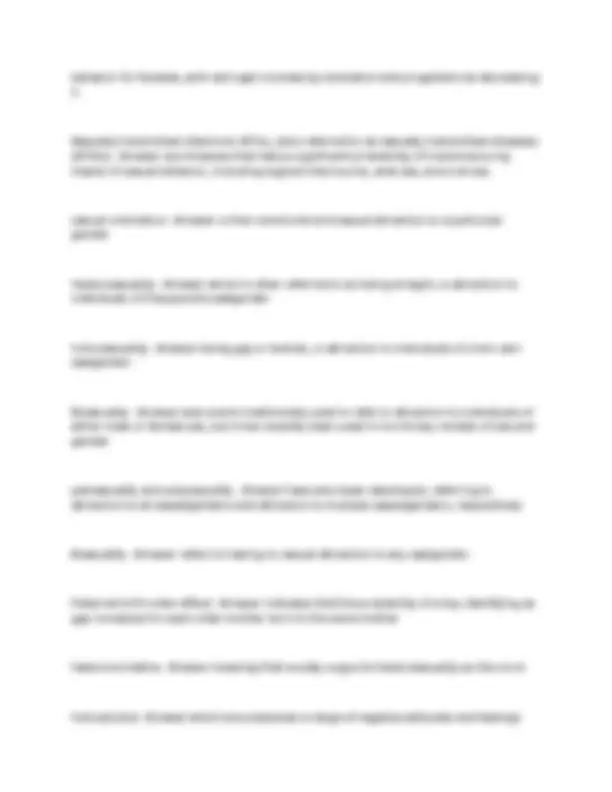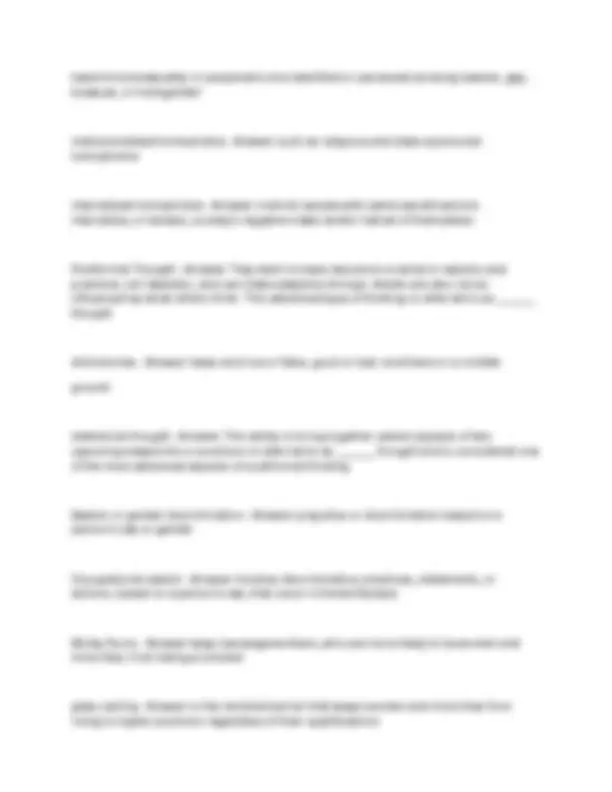






Study with the several resources on Docsity

Earn points by helping other students or get them with a premium plan


Prepare for your exams
Study with the several resources on Docsity

Earn points to download
Earn points by helping other students or get them with a premium plan
Community
Ask the community for help and clear up your study doubts
Discover the best universities in your country according to Docsity users
Free resources
Download our free guides on studying techniques, anxiety management strategies, and thesis advice from Docsity tutors
A comprehensive overview of key concepts and theories related to adult development, focusing on emerging adulthood, gender identity, human sexuality, and postformal thought. It explores the characteristics of emerging adulthood, the social construction of gender, the complexities of human sexuality, and the development of advanced cognitive abilities in adulthood. The document also touches upon various social and psychological factors influencing adult development, including temperament, attachment styles, and relationship dynamics.
Typology: Exams
1 / 8

This page cannot be seen from the preview
Don't miss anything!





ages 18-25 - Answer Emerging adulthood is the period between ages ____ and ____ -age of identity exploration -age of instability-age of self-focus -age of feeling in- between-age of possibilities - Answer Arnett identified five characteristics of emerging adulthood that distinguished it from adolescence and young adulthood Socioeconomic Class and Emerging Adulthood: - Answer Name this theory. Overall,Arnett concluded that emerging adulthood exists wherever there is a period between the end of adolescence and entry into adult roles, but acknowledging social, cultural,and historical contexts was also important.
body mass index - Answer expressed as weight in kilograms divided by height in meterssquared. This term is commonly used to classify overweight.
gender - Answer the cultural, social and psychological meanings associated withmasculinity and feminity
gender identity - Answer A person's sense of self as a member of a particular gender isknown as
social construct - Answer meaning that it does not exist naturally, but is instead a
concept that is created by cultural and societal norms gender roles - Answer the societal expectations associated with being male or female gender binary - Answer categorizing humans as only female and male Two-spirit - Answer a modern umbrella term used by some indigenous North Americansto describe gender-variant individuals in their communities
minority stress model - Answer states that an unaccepting social environment results inboth external and internal stress which contributes to poorer mental health.
transvestite - Answer which is the practice of dressing and acting in a style or mannertraditionally associated with another sex
Human sexuality - Answer refers to people's sexual interest in and attraction to others,as well as their capacity to have erotic experiences and responses.
libido - Answer Sexual motivation, often referred to as ______, is a person's overallsexual drive or desire for sexual activity.
sexual response cycle - Answer a model that describes the physiological responses thattake place during sexual activity.
-The excitement phase-The plateau phase -Orgasm is the release of tension -resolution period - Answer four phases of sexual response:1.
behavior for females, with estrogen increasing motivation and progesterone decreasingit.
Sexually transmitted infections (STIs), (also referred to as sexually transmitted diseases(STDs)) - Answer are illnesses that have a significant probability of transmission by means of sexual behavior, including vaginal intercourse, anal sex, and oral sex. sexual orientation - Answer is their emotional and sexual attraction to a particulargender
Heterosexuality - Answer which is often referred to as being straight, is attraction toindividuals of theopposite sex/gender
homosexuality - Answer being gay or lesbian, is attraction to individuals of one's ownsex/gender.
Bisexuality - Answer was a term traditionally used to refer to attraction to individuals ofeither male or female sex, but it has recently been used in non binary models of sex and gender pansexuality and polysexuality - Answer have also been developed, referring toattraction to all sexes/genders and attraction to multiple sexes/genders, respectively
Asexuality - Answer refers to having no sexual attraction to any sex/gender. fraternal birth order effect - Answer indicates that the probability of a boy identifying asgay increases for each older brother born to the same mother
heteronormative - Answer meaning that society supports heterosexuality as the norm. homophobia - Answer which encompasses a range of negative attitudes and feelings
toward homosexuality or people who are identified or perceived as being lesbian, gay,bisexual, or transgender
institutionalized homophobia - Answer such as religious and state-sponsoredhomophobia
internalized homophobia - Answer in which people with same-sex attractionsinternalize, or believe, society's negative views and/or hatred of themselves.
Postformal Thought - Answer They learn to base decisions on what is realistic andpractical, not idealistic, and can make adaptive choices. Adults are also not as influenced by what others think. This advanced type of thinking is referred to as _______thought
dichotomies - Answer ideas are true or false; good or bad; and there is no middle ground. dialectical thought - Answer This ability to bring together salient aspects of twoopposing viewpoints or positions is referred to as _______ thought and is considered one of the most advanced aspects of postformal thinking Sexism or gender discrimination - Answer prejudice or discrimination based on aperson's sex or gender
Occupational sexism - Answer Involves discriminatory practices, statements, oractions, based on a person's sex, that occur in the workplace.
Sticky floors - Answer keep low-wage workers, who are more likely to be women andminorities, from being promoted
glass ceiling - Answer is the invisible barrier that keeps women and minorities fromrising to higher positions regardless of their qualifications
mere exposure - Answer the tendency to prefer stimuli (including, but not limited topeople) that we have seen more frequently.
Passion - Answer refers to the intense, physical attraction partners feel toward oneanother.
Intimacy - Answer involves the ability the share feelings, psychological closeness andpersonal thoughts with the other.
Commitment - Answer is the conscious decision to stay together. hookups - Answer involve uncommitted sexual encounters Friends with Benefits (FWB) or "Booty Calls." - Answer These relationships involvefriends having casual sex without commitment.
Catfishing - Answer refers to "a deceptive activity involving the creation of a fake onlineprofile for deceptive purposes"
endogamy - Answer indicate the groups we should marry within and those we should notmarry in
homogamy - Answer or marriage between people who share social characteristics. situational couple violence - Answer which is the violence that results when heatedconflict escalates
intimate terrorism - Answer in which one partner consistently uses fear and violence todominate the other
bidirectional - Answer Not only do parents affect their children, children influence theirparents
psychological moratorium - Answer where teens put on hold commitment to an identitywhile exploring the options.
Identity diffusion - Answer is a status that characterizes those who have neitherexplored the options, nor made a commitment to an identity.
dentity foreclosure - Answer have made a commitment to an identity without havingexplored the options.
Identity moratorium - Answer is a status that describes those who are activity exploringin an attempt to establish an identity but have yet to have made any commitment.
Identity achievement - Answer refers to those who after exploration have made acommitment.
Ethnic identity - Answer refers to how people come to terms with who they are based ontheir ethnic or racial ancestry